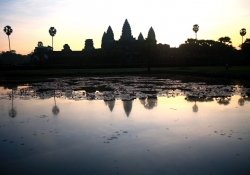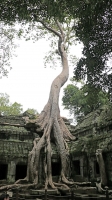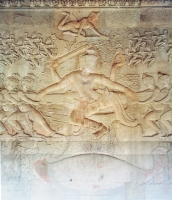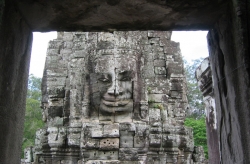Built in the early 1100’s by the Khmer King Suryavarman II, the temples at Angkor represent one of the most advanced architectural achievements in relation to its time. The temple was originally dedicated to the Hindu god, Vishnu, but later became a site for practitioners of Buddhism. Today, the site is a major tourist location, pulling in upwards of 600,000 foreigners every year. Efforts to preserve and restore the temple have been ongoing since the 1980’s and various countries have made efforts to protect the site including, the U.S., France, Germany, and Japan.
Conflicting theories exist in relation to the temple’s purpose. Unlike most of the other temples in the area, Angkor Wat’s main entrance faces westward. This has led some historians to believe that the temple was actually built as a funerary site for Suryavarman II. However, others reason that the temple faces west because the Hindu god, Veshnu, was affiliated with that direction. Regardless of the site’s purpose, though, it is agreed that Angkor Wat was once one of the largest cities in the world, and that it combined secularism and spiritualism.
Angkor Wat was built early in 1100s by Suryavarman II over an estimated 30 year period. It honors Vishnu, and the ruins are a symbolic structure of Hindu cosmology. The temple is located about 4 miles to the north of Siem Reap and south of Angkor Thom, its only accessible entrance through the gate to the west.
Angkor Wat is one of the largest religious sites in the world, covering around 500 acres of land. Its five walls and moats are a representation of mountainous chains, as well as the cosmic ocean. The vast compound’s short dimensions are aligned precisely along the north-south axis, and the east to west axis was diverted deliberately 0.75° to give its observers an anticipation of the equinox in spring for three days.
Pictures & Photos
 Angkor Wat Towers Seen From the West Main Approach
Angkor Wat Towers Seen From the West Main ApproachPhoto by: cornstaruk
 Moat View of the Angkor Wat
Moat View of the Angkor WatPhoto by: jurvetson
 Sunrise Over Angkor Wat
Sunrise Over Angkor WatPhoto by: jurvetson
 Interesting Color View of Angkor Wat
Interesting Color View of Angkor WatPhoto by: tylerdurden1
 Aerail View of Angkor Wat
Aerail View of Angkor WatPhoto by: WikiCommons
 Beautiful View of the Sky and the Reflected Shadow
Beautiful View of the Sky and the Reflected ShadowPhoto by: inottawa
 Light Up at Night
Light Up at NightPhoto by: mckaysavage
 How Old Is This Tree/
How Old Is This Tree/Photo by: alfaneque
 Angkor Wat Reflected in The Clear Water
Angkor Wat Reflected in The Clear WaterPhoto by: cornstaruk
 Another Angle of Angkor Wat
Another Angle of Angkor WatPhoto by: visualcuriosity
 How Can This Tree Survive?
How Can This Tree Survive?Photo by: Augapfel
 Sunset, Too Dark To See Anything
Sunset, Too Dark To See AnythingPhoto by: James Khoo
 Nice View of the Temple, Too Much Tourists Though
Nice View of the Temple, Too Much Tourists ThoughPhoto by: gumuz
 What is That Kid Pointing At?
What is That Kid Pointing At?Photo by: permanently scatterbrained
 These Monks Have Nothing to Do?
These Monks Have Nothing to Do?Photo by: beggs
 North Library at Angkor Wat
North Library at Angkor WatPhoto by: Augapfel
 Viewed From the Northwest
Viewed From the NorthwestPhoto by: WikiCommons
 Another Section of the Angkor Wat
Another Section of the Angkor WatPhoto by: jenniferphoon
 Devatas (Female Guardians), Fount at Angkor Wat
Devatas (Female Guardians), Fount at Angkor Wat Photo by: WikiCommons
 The Bas Relief of the Churning of the Sea
The Bas Relief of the Churning of the SeaPhoto by: WikiCommons
 Who Stole The Buddha's Head?
Who Stole The Buddha's Head?Photo by: mckaysavage
 Angkor Thom - North of Angkor Wat
Angkor Thom - North of Angkor WatPhoto by: permanently scatterbrained
 Angkor Thom - Attracts More Archeologists Than Tourists
Angkor Thom - Attracts More Archeologists Than TouristsPhoto by: jurvetson
 Who is He Smiling At? Found At Bayon Temple, Angkor Thom
Who is He Smiling At? Found At Bayon Temple, Angkor ThomPhoto by: The Wandering Angel
